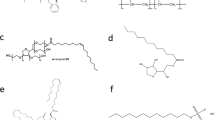Abstract
Antibiotic-encapsulated PLA and PLGA nanoparticles were prepared by the single emulsion-solvent evaporation technique. Different PLA and PLGA systems were prepared, varying the copolymer composition and the amount of the surfactant polyvinyl alcohol. Characterization and drug loading studies were performed by UV-Visible spectrophotometry, dynamic light scattering, and scanning electron microscopy (SEM).
Simultaneously, in order to model the diffusion of the nanoparticles within the osteoblast, QDs such as functionalized InGaP/ZnS and polymer encapsulated InGaP/ZnS nanoparticles were added to confluent cultures of primary mouse osteoblasts. Following PreFer fixation, cultures were examined via confocal microscopy. QDs were clearly visible within osteoblasts.
Similar content being viewed by others
References
K. S. Soppimath, T. M. Aminadhavi, A. R. Kulkarni, W. E. Rudzinski, “Biodegradable polymeric nanoparticles as drug delivery devices”, J. of Controlled Release, 70, 1–20 (2001).
C. X. Song, V. Labhasetwar, H. Murphy, X. Qu, W.R. Humphrey, R. J. Shebuski, R. J. Levy, “Formulation and characterization of biodegradable nanoparticles for intravascular local drug delivery”, J. of Controlled Release, 43, 197–212 (1997).
J. H. Calhoun, J. T. Mader, “Treatment of Osteomyelitis with a Biodegradable Antibiotic Implant”, Clinical Orthopaedics and Related Research, 341, 206–214 (1997).
T. K. Mandal, L. A. Bostanian, R. A. Graves, S. R. Chapman, “poly(d,l-Lactide-Co-Glycolide) Encapsulated Poly(Vinyl Alcohol) Hydrogel as a drug Delivery System”, Pharmaceutical Research, 19, 1713–1719 (2002).
T. J. de Faria, A. Machacado de Campos, E. Lemos Senna, “Preparation and Characterization of Poly(D,L-Lactide )(PLA) and Poly(D,L-Lactide)-Poly(Ethylene Glycol) (PLA-PEG) Nanocapsules Containing Antitumoral Agent Methotrexate”, Macromol. Symp”, 229, 228–233 (2005).
A. Lamprecht, N. Ubrich, M. Hombreiro Perez, C. M. Lehr, M. Hoffman, P. Maaincent, “Biodegradable monodispersed nanoparticles prepared by pressure homogenization-emulsification”, International Journal of Pharmaceutics, 184, 97–105 (1999).
C. E. Astete, C. M. Sabliov, “Synthesis and Characterization of PLGA Nanoparticles”, J. Biomater. Sci. Polymer Edn., 17, 247–289 (2006).
M. L. Hans, A. M. Lowman, “Biodegradable nanoparticles for drug delivery and targeting”, Solid State & Material Science, 6, 319–327 (2002).
M. N. V. Ravi Kumar, U. Bakowsky, C. M. Lehr, “Preparation and Characterization of cationic PLGA Nanospheres as DNA carries”, Biomaterials, 25, 1771–1777 (2004).
C. T. Laurencin, A. M. Attawia, L. Q. Lu, M. D. Borden, H. H. Lu, W. J. Gorum, J. R. Lieberman, “Poly(lactide-co-glycolide)/hydroxyapatite delivery of BMP-2-producing cells: a regional gene therapy approach to bone regeneration”, Biomaterials, 22, 1271–1277 (2001).
K. E. Gonsalves, S. Jin, M. I. Baraton, “Synthesis and surface characterization of functionalized polylactide copolymer microparticles”, Biomaterials, 19, 1501–1505 (1998).
H. Kwon, J. Lee, S. Choi, Y. Jang, J. Kim, “Preparation of PLGA nanoparticles containing estrogen by emulsification-diffusion method”, Colloids and Susfaces, 182, 123–130 (2001).
J. Panyam, V. Labhasetwar, “Biodegradable nanoparticles for drug delivery to cells and tissue”, Advanced Drug Delivery Reviews, 55, 329–347 (2003).
B. C. Lagerholm, M. Wang, L. A. Ernst, D. H. Ly, H. Liu, M. P. Bruchez, A. S. Waggoner, “Multicolor Coding of Cells with Cationic Peptide Coated Quantum Dots”, Nanoletters, 4, 2019–2022 (2004).
M. P. Bruchez, M. Moronne, P. Gin, S. Weiss, A. P. Alivisatos, “Conjugation of Luminescent Quantum Dots with Antibodies Using an Engineered Adaptor Protein to Provide New Reagents for Fluoroimmunoassays”, Science, 281, 2013–2016 (1998).
D. R. Larson, W. R. Zipfel, R. M. Williams, S. W. Clark, M. P. Bruchez, F. W. Wise, W. W. Webb, “Water-Soluble Quantum Dots for Multiphoton Fluorescence Imaging in Vivo”, Science, 300, 1434–1436 (2003).
J. K. Jaiswal, H. Mattoussi, J. M. Mauro, S. M. Simon, “Long-term multiple color imaging of live cells using quantum dot bioconjugates”, Nature Biotechnology, 21, 47–51 (2003).
S. J. Rosenthal, I. Tomlinson, E. M. Adkins, S. Schroeter, S. Adams, L. Swafford, J. McBride, Y. Wang, L. J. DeFelice, R. D. Blakely,” Targeting Cell Surface Receptors with Ligand-Conjugated Nanocrystals”, J. Am. Chem. Soc., 124, 4586–4594 (2002).
J. K. Ellington, M. Harris, L. Webb, B. Smith, T. Smith, K. Tan, M. Hudson, “Intracellular Staphylococcus aureus. A mechanism for the indolence of Osteomyelitis”, J. Bone Joint Surg. Br. 85(6), 918–21 (2003).
M. Lucke, G. Schmidmaier, S. Sadoni, B. Wildemann, R. Schiller, A. Stemberger, N.P. Haas, M. Raschke., “A new model of implant-related osteomyelitis in rats”. J. Biomed Mater. Res. B Appl. Biomater., 67(1), 593–602 (2003).
J. K. Ellington, S. S. Reilly, W. K. Ramp, M. S. Smeltzer, J. F. Kellam, M. C. Hudson “Mechanisms of Staphylococcus aureus invasion of cultured osteoblasts”, Microb. Pathog., 26(6), 317–23 (1999).
E. H. Alexander, F. A. Rivera, I. Marriot, J. Anguita, K. L. Bost, M.C. Hudson, “Staphylococcus aureus-induced tumor necrosis factor-related apoptosis-inducing ligand expression mediates apoptosis and caspase-8 activation in infected osteoblasts”. BMC Microbiol, 3, 5 (2003)
L. M. Varela, M. Garcia, M. Perez-Rodriguez, P. Taboada, J. M. Ruso, V. Mosquera,” Multilayer adsorption model for the protein-ligand interaction”, Journal of Chemical Physics, 114(17), 7682–7687 (2001).
M. Zweers, G. Engbers, D. Grijpma, J. Feijen,” Release of anty-restenosis drugs from poly(ethylene oxide)-poly(dl-lactic-co-glycolic acid) nanoparticles”, Journal of Controlled Release, 114(3), 317–324 (2006).
Author information
Authors and Affiliations
Rights and permissions
About this article
Cite this article
Rabinovich, M., Somayaji, S.N., Pillai, R.R. et al. Active Polymer Nanoparticles: Delivery of Antibiotics. MRS Online Proceedings Library 1019, 506 (2007). https://doi.org/10.1557/PROC-1019-FF05-06
Received:
Accepted:
Published:
DOI: https://doi.org/10.1557/PROC-1019-FF05-06




